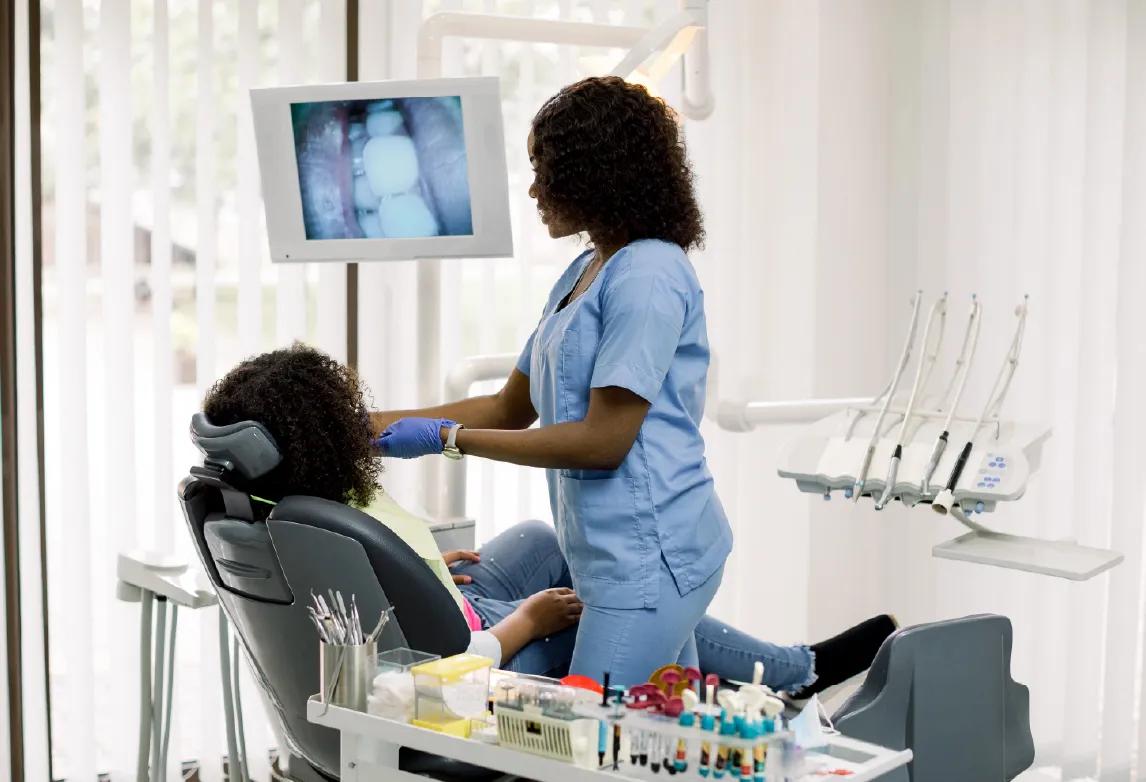Dental Assistant vs Dental Hygienist: Understanding the Differences

Not only do dental professionals help give patients a whiter, brighter smile, but good oral health is important for eating, speaking, and showing emotion — with poor oral health linked to pain, reduced academic performance, lower productivity, and even reduced quality of life.1 If you’re considering a career in the dental field but aren’t interested in becoming a dentist, two other options are dental assistant and dental hygienist. What’s the difference?
Defining Dental Assistant and Dental Hygienist Roles
Before we get into the key differences between a dental assistant and a dental hygienist, let’s first clarify each role.
What Is a Dental Assistant?
Dental assistants help dentist offices run smoothly by preparing both patients and work areas for the dental visit, assisting the dentist during procedures, and performing administrative tasks like scheduling appointments and updating patient records. Some dental assistants are trained to perform more complex functions. They are called dental assistants with expanded functions and may be tasked with advanced tasks (under the direction of a dentist), such as fabricating temporary restorations or creating impressions.
What Is a Dental Hygienist?
Dental hygienists also perform several important functions, many of which are centered around patient care. For instance, dental hygienists can examine patients for oral disease; provide care to help prevent future or worsening issues with the patient’s mouth, teeth, or gums; and educate patients about proper oral hygiene techniques or the importance of good oral health.2
Responsibilities and Duties of a Dental Hygienist vs Dental Assistant
One way to understand the differences between a dental hygienist and a dental assistant is to look at their job duties.
What Does a Dental Assistant Do?
A dental assistant’s duties can vary from state to state, as well as from employer to employer. With this in mind, the Dental Assisting National Board (DANB) shares that individuals in these roles generally perform a variety of tasks, including:3
- Prepping the room and sterilizing dental instruments
- Greeting patients and seating them in the room
- Taking X-rays
- Assisting the dentist with patient procedures
- Providing post-procedure care instructions to patients
Dental assistants may also perform administrative duties according to the Bureau of Labor Statistics (BLS), such as:4
- Recording the dental treatment
- Scheduling appointments
- Assisting patients with billing or payment
What Does a Dental Hygienist Do?
After looking at all the things a dental assistant does, you may wonder what’s left for a dental hygienist to do. Lots!
Tasks performed by a dental hygienist include:2
- Taking and developing X-rays
- Assessing patients’ oral health
- Removing tartar, plaque, and stains from patients’ teeth
- Applying tooth protectants, such as sealants and fluorides
- Educating patients about good oral hygiene and ways to improve oral health
- Documenting procedures performed and the treatment plans
Education and Training for Dental Assistants and Dental Hygienists
If you’re considering becoming a dental assistant or dental hygienist, it’s important to know the education and training required.
How to Become a Dental Assistant
The BLS reports that some states have no educational requirements for dental assistants, leaving individuals to learn required skills through on-the-job training, while other states require the completion of an accredited training program and passing of an exam.5
An accredited dental assistant program takes roughly one year to complete and includes both classroom instruction and labs. The BLS adds that this type of program is available at community colleges, as well as vocational or technical schools, and typically includes practical (supervised) experience and provides the learner with a certificate or diploma.
How to Become a Dental Hygienist
If you want to become a dental hygienist, more schooling is required. Most hygienists need at least an associate degree according to the BLS (which takes about three years to complete), though some pursue their bachelor’s degree — particularly if they want to do research, teach, or work in public health programs or schools.6
The BLS adds that these programs generally include classroom instruction, in addition to clinicals and labs. Dental hygiene programs can be found at community colleges, universities, and technical schools.
Job Outlook for Dental Assistants and Dental Hygienists
One area where dental assistants and hygienists are similar is in their job outlook.
The BLS projects that dental assistant positions are projected to grow 8% between 2023 and 2033, resulting in roughly 54,900 openings per year, on average.7 The projected growth rate for dental hygienists during the same time frame is just one percentage point higher (9%), which would create approximately 16,400 openings annually.8
The BLS indicates that both positions are expected to be more in demand due to an aging population. Plus, research continues to connect oral health with general health, causing more people to pursue preventive dental services.
Dental Assistant or Dental Hygienist? Choosing a Career Path for You
At this point, you may know which dental position may be a better fit for you. But if you’re still unsure, it can help to consider these factors:
- How soon do you want to enter the field? If you want to start working sooner rather than later, a Dental Assistant diploma or certificate can prepare you for this role within approximately 12 months,5 whereas a typical Dental Hygienist program takes roughly three years to complete.6
- What level of patient service do you want to provide? If you’re more interested in performing administrative or “assisting” tasks, you may be more satisfied with a dental assistant position. Conversely, if you want to perform patient examinations or preventive procedures, you might be happier as a dental hygienist.
- How much do you want to spend on your education? It typically costs more to earn a degree than a diploma — possibly tens of thousands more.9 If you want to try and keep your costs lower, you may want to pursue a dental assistant diploma versus a dental hygienist degree.
Should you decide to pursue a dental hygienist career path, finding a school that offers this training is a good next step. UMA does not make any recommendations as to which school to choose as we do not offer a dental hygienist program. However, if you decide to pursue a dental assistant career path, we may be able to help.
Ready to Pursue a Dental Assistant Career Path?
If becoming a dental assistant sounds like the career path for you, UMA offers a Dental Assistant diploma program. This program consists of online learning combined with on-campus training, providing a blended educational approach.
Our Dental Assistant diploma program can be completed in 12 months or more10 and includes a 240-hour on-site externship. It also prepares you to sit for the Registered Dental Assistant (RDA) exam should you decide to pursue this certification. Learners must meet eligibility criteria to sit for applicable certification exams.
Note: UMA does not provide certification for any allied health field. Instead, we offer students preparation to sit for the RDA exam. Learners must meet eligibility criteria to sit for applicable certification exams.
Why Complete Dental Assistant Schooling at UMA?
One thing you should know about UMA is that care is at our core. We believe that if we care for our learners, such as through a variety of student support services, our learners may better care for others. We call this the ripple effect of care, where its effects extend beyond the learner and into the communities they serve, even helping to somewhat positively impact society.
Whether you need help with admissions, financial aid (if qualified), academics, or any other facet of your learning journey, we are here for you. We’re even here for you beyond graduation, offering our graduates access to our Career Services team who can help with resumes, job interview prep, and more.
Contact us today to learn more about what we can do for you as you pursue your healthcare career journey!
FAQs:
- How much does a dental assistant make? Your pay as a dental assistant can vary based on a variety of factors, such as your level of education and experience, relevant certifications, and geographic location. You can find wage information from several online resources, such as the Bureau of Labor Statistics (BLS) and others.
- How do you become a dental assistant? Some states allow on-the-job training while others require that dental assistants complete an accredited training program and pass an exam.5 To learn the requirements in your state, the Dental Assisting National Board provides an online state dental assisting requirements search.
- How long does it take to become a dental assistant? Many dental assistant training programs can be completed in roughly one year according to the Bureau of Labor Statistics, resulting in a certificate or diploma.5
Where national data regarding earnings or employability within a particular field are cited, individual readers should take note that national averages may not accurately reflect the earnings of workers in their particular part of the country, and may include earners at all stages of their career, not just entry-level wages for recent graduates.
1 Centers for Disease Control and Prevention. About Oral Health. https://www.cdc.gov/oral-health/about/index.html
2 Bureau of Labor Statistics. Occupational Outlook Handbook. Dental Hygienists. https://www.bls.gov/ooh/healthcare/dental-hygienists.htm#tab-2
3 Dental Assisting National Board. Become a Dental Assistant. https://www.danb.org/career-center/become-a-dental-assistant
4 Bureau of Labor Statistics. Occupational Outlook Handbook. Dental Assistants. https://www.bls.gov/ooh/healthcare/dental-assistants.htm#tab-2
5 Bureau of Labor Statistics. Occupational Outlook Handbook. Dental Assistants. https://www.bls.gov/ooh/healthcare/dental-assistants.htm#tab-4
6 Bureau of Labor Statistics. Occupational Outlook Handbook. Dental Hygienists. https://www.bls.gov/ooh/healthcare/dental-hygienists.htm#tab-4
7 Bureau of Labor Statistics. Occupational Outlook Handbook. Dental Assistants. https://www.bls.gov/ooh/healthcare/dental-assistants.htm#tab-6
8 Bureau of Labor Statistics. Occupational Outlook Handbook. Dental Hygienists. https://www.bls.gov/ooh/healthcare/dental-hygienists.htm#tab-6
9 Sallie Mae. Differences Between Certificate and Degree Programs. https://www.salliemae.com/blog/certificate-vs-degree-programs/
10 Completion times vary according to the individual student.
Request Information
Talk with us. Start your journey.
Complete this form and we'll call you to explore options at UMA and answer your questions. We'll also email you info on how to get started. We're with you at every step!
Request Information
Talk with us. Start your journey.
Complete this form and we'll call you to explore options at UMA and answer your questions. We'll also email you info on how to get started. We're with you at every step!
About the Author
 Christina DeBusk
Christina DeBuskChristina DeBusk is a freelance writer who has been providing health and wellness content to healthcare organizations such as the American Chiropractic Association and International Sports Sciences Association (ISSA) since 2011. She obtained her Bachelor of Science in Sociology from Central Michigan University, minoring in psychology. She has also earned several ISSA certifications, including Certified Personal Trainer and Certified Nutrition Specialist, achieving the status of Elite Trainer.
Related Content


